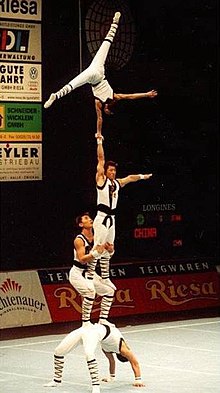
Back جمباز بهلواني Arabic Akrobatik gimnastika Azerbaijani Спортна акробатика Bulgarian Gimnàstica acrobàtica Catalan Akrobatická gymnastika Czech Sports acrobatik Danish Sportakrobatik German Ακροβατική γυμναστική Greek Akrobata gimnastiko Esperanto Gimnasia acrobática Spanish
 Women's trio | |
| Highest governing body | Federation International Gymnastics |
|---|---|
| First contested | Soviet Union, 1930s |
| Characteristics | |
| Contact | Not with opponents |
| Mixed-sex | No (except mixed pairs) |
| Type | Gymnastics sport |
| Presence | |
| Country or region | Worldwide |
| Olympic | No |
| World Games | 1993 – 2021[1] |



Acrobatic gymnastics is a competitive discipline of gymnastics where partnerships of gymnasts work together and perform routines consisting of acrobatic skills, dance and tumbling, set to music. There are three types of routines; a 'balance' routine (at FIG level 5 and above) where the focus is on strength, poise and flexibility; a 'dynamic' routine (also FIG level 5 and above) which includes throws, somersaults and catches, and (at FIG level 6 and above, as well as level 4 and below) a 'combined' routine which includes elements from both balance and dynamic.
The sport is governed by the International Federation of Gymnastics (FIG, an abbreviation of Federation International Gymnastics). In acrobatic gymnastics, there are different levels based on the difficulty and skills involved. The levels typically include beginners being level 2-4, intermediates being level 5-10, and Elites being level 11-19. Levels 2-4 focuses on basic skills and routines. It includes foundational elements like balances, dynamic skills, and choreography. Levels 5-10 start to showcase more complex skills as the level goes up. Gymnast at these levels display advanced acrobatic elements, strength, flexibility, and coordination in their routines. Elites are the highest level in acrobatic gymnastics, levels 11-19 features elite gymnast performing extremely difficult and intricate routines. These routines require exceptional strength, flexibility, precision, and teamwork. Each level in acrobatic gymnastics builds upon the skills learned in the previous levels, gradually increasing in complexity and difficulty as gymnasts progress in their training and abilities.
Acrobatic gymnasts perform in pairs, trio's or groups and enter into and are judged at a specific level or age group category. In each partnership, the gymnasts' different sizes and abilities will be balanced to complement each other in order to carry out the complex moves. Some will mainly carry out supporting and pitching roles and are known as bases. They are then balanced with usually smaller gymnasts who become the 'tops'. In men's and women's groups there are also one or two 'middles', who are like another base who usually will support the top while balancing on the base. The different partnerships seen in competition are:
- women's pair (two females)
- men's pair (two males)
- mixed pair (a male base and a female top)
- women's trio's (three females)
- men's group (four males)
As well as this, in levels 5-Elite there can be mixed groups (4 people from both genders). In competition, partnerships perform a routine to music, that has usually been choreographed specifically for them. The gymnasts carry out their acrobatic moves and combine them with dance, all in time to and in keeping with the style of the music. Partnerships are judged on artistry/dance (worth 10.0 points out of 31.5) execution of skills (marked out of 10 and doubled to give 20.0 points out of 31.5) and difficulty of skill (worth 1.5 out of 31.5).
The rules for the sport, known as the Code of Points, are governed by the FIG. These rules are subject to change every four years in line with the Olympic cycle, as in other disciplines of gymnastics.
- ^ "Gymnastics on the program of the world games". The World Games.
© MMXXIII Rich X Search. We shall prevail. All rights reserved. Rich X Search